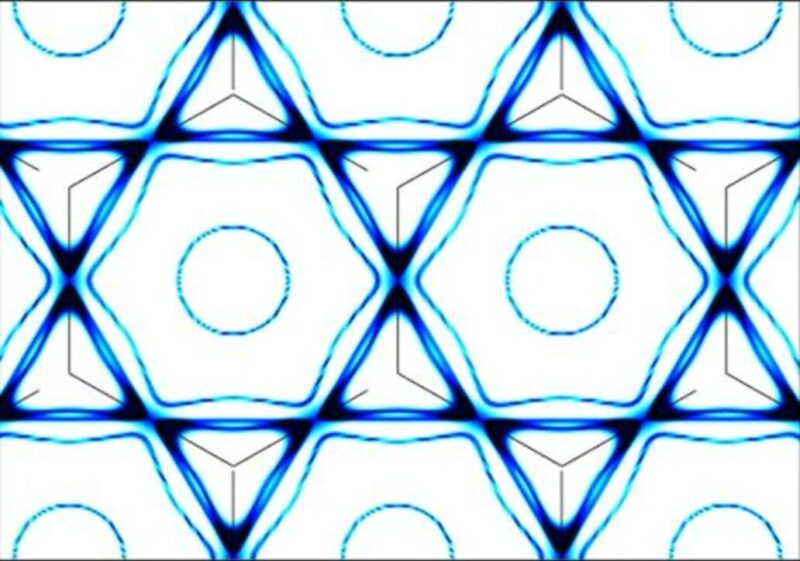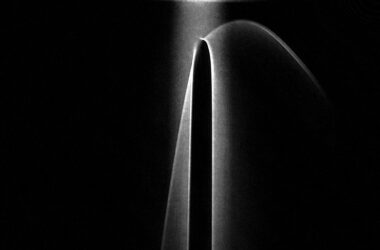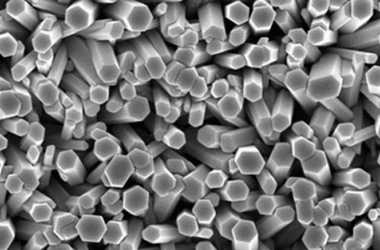
Visualisation des états électroniques à énergie nulle – également appelés “surface de Fermi” – du matériau kagome étudié par Riccardo Comin du MIT et ses collègues. Le matériau kagome spécifique exploré dans le travail actuel est composé de seulement trois éléments (césium, vanadium et antimoine) et a la formule chimique CsV3Sb5. Crédit : Laboratoire Comin, MIT
Les travaux permettront de concevoir d’autres matériaux quantiques inhabituels ayant de nombreuses applications potentielles.
MIT physicists and colleagues, including scientists from Berkeley Lab, have discovered the “secret sauce” behind the exotic properties of a new quantum material known as a kagome metal.
Kagome metals have long mystified scientists for their ability to exhibit collective behavior when cooled below room temperature.
One of the resulting properties is superconductivity, which allows a material to conduct electricity extremely efficiently.
In a regular metal, electrons behave much like people dancing individually in a room. In a kagome superconductor, when the material is cooled to 3 Kelvin (approximately minus 454 degrees Fahrenheit) the electrons begin to move in pairs, like couples at a dance.
At 100 Kelvin, the kagome material exhibits yet another strange kind of behavior known as charge density waves. In this case, the electrons arrange themselves in the shape of ripples.
A research team led by MIT assistant professor of physics Riccardo Comin discovered that the “secret sauce” behind kagome electrons’ unusual synchronicity is due to another behavior known as an electronic singularity, or the Van Hove singularity, which involves the relationship between the electrons’ energy and velocity. They reported their finding in a recent issue of the journal Nature Physics.
When many electrons exist at once with the same energy in a material, they are known to interact much more strongly. As a result of these interactions in the presence of this singularity, the electrons can pair up and become superconducting or form charge density waves.
Comin noted that relating the energy to the velocity of electrons in a solid is challenging and required special instruments at two international synchrotron research facilities: Beamline 4A1 of the Pohang Light Source, and Beamline 7.0.2 (MAESTRO) of Berkeley Lab’s Advanced Light Source (ALS). A synchrotron is a particle accelerator that generates extremely bright beams of light ranging in photon energies from the infrared through X-rays.
With assistance from ALS staff scientist Chris Jozwiak, the team used a technique called Angle-resolved Photoemission Spectroscopy, or ARPES, which utilizes very bright, monochromatic X-ray light focused into a small beam just 10 micrometers (or 10 thousandths of a meter) wide. The technique allowed the team to accurately identify and measure the velocities of the electrons central to the interesting properties of the material.
“You need a large light-source user facility like the ALS to do these kinds of sophisticated experiments with new materials. The MAESTRO beamline at the ALS offers a very precise and bright source of photons that can be tuned to a wide range of wavelengths, or energies. If our doors weren’t open to the public, work such as this exciting discovery by the Comin group wouldn’t be possible,” Jozwiak said.
For more on this discovery, see Physicists Discover “Secret Sauce” Behind Unusual Exotic Properties of New Quantum Material.
Reference: “Twofold van Hove singularity and origin of charge order in topological kagome superconductor CsV3Sb5” by Mingu Kang, Shiang Fang, Jeong-Kyu Kim, Brenden R. Ortiz, Sae Hee Ryu, Jimin Kim, Jonggyu Yoo, Giorgio Sangiovanni, Domenico Di Sante, Byeong-Gyu Park, Chris Jozwiak, Aaron Bostwick, Eli Rotenberg, Efthimios Kaxiras, Stephen D. Wilson, Jae-Hoon Park and Riccardo Comin, 13 January 2022, Nature Physics.
DOI: 10.1038/s41567-021-01451-5



